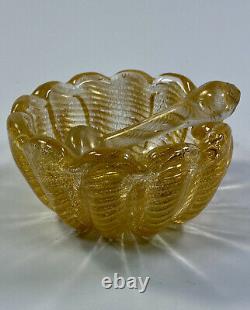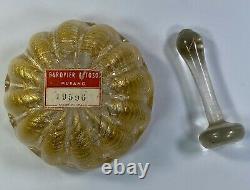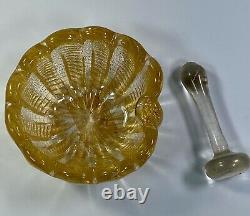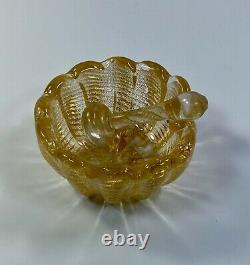C1950s Barovier & Toso Murano Italy Cordonato d'Oro Series Glass Bowl & Pestle






A Circa 1950s Ercole Barovier design for Barovier & Toso Murano, Italy Cordonato d'Oro series done in heavy gold leaf glass bowl with pestle. Paper label still intact Barovier & Toso at the base which dates the piece from 1936 to 1955. Both the bowl and the pestle are in excellent mid century condition free of any cracks, chips, or repairs. The bowl measures 3-1/4" or 8 cm across by 1-3/4" or 4.5 cm tall and the pestle measures 2-3/4 or 7 cm long. The origins of the Barovier & Toso glass factory can be traced back to 1878, when Benvenuto and Giuseppe Barovier founded the Barovier brothers.
Shortly after, the glassworks took the name of Artisti Barovier, producing blown glassware of the classic type and Art Nouveau-inspired objects as in "Piume" and also using polychrome murrine and tessere. In 1914, the Artisti Barovier took part in the Flower Show at the Doge's Palace. During the First World War, the glass factory moved to Livorno, and upon its return to Murano in 1919, it took the name of Vetreria Artistica Barovier & C. Headed by Ercole and Nicolò Barovier. The production of murrine vases intensifies, based on designs by Vittorio Zecchin and Wolf Ferrari; new "iron and glass" combinations are experimented with the collaboration of the firm Cardin & Fontana of Venice, presented in 1923 at the International Exhibition of Decorative Arts in Monza. In 1926 Ercole Barovier definitively took over the artistic direction of the company, inventing processing techniques that will contribute to the renewal of glass art and with an artistic production of over 20,000 models. The new technique of "hot coloring without fusion", which using very thick materials, with inclusions of various substances, causes polychrome reactions, leads to the creation of the "Primavera" glass, a limited series exhibited at the 1930 Biennale. Reused with various modifications, even in the 1950s.In 1937, the glassworks participated in the Paris International Exposition, obtaining the Grand Prix. Ercole Barovier used thick colorless glass, enriching it with applications, inclusions and air bubbles. In 1938 the "Rostrati" were produced, glass with the surface characterized by large regular, degrading points. The "Bugnati", "Lenti", "Superbolle", which appeared in the following years, belong to this series. In 1936, the merger with S.
Ferro-Toso, taking the name of Ferro-Toso-Barovier, which was maintained until 1939, the year in which it changed to Barovier-Toso & C. In 1942, a new merger with the glassworks of Murano F. Lli Toso will bring to the current company name Barovier & Toso. In 1940, Barovier-Toso & C presented various works at the Milan Triennale, including: "Rugiada", "Groviglio", "Oriente" and "Rilievi aurati". The post-war production was characterized by rather simple forms, with the experimentation of new uses of traditional techniques, such as those on murrine, obtaining unprecedented chromatic effects.At the Milan Triennale in 1951, the following vases were presented: "Corinto", "Damasco", "Millefili", "Sidone", "Parabolici", "Moreschi" and "a Spina". In the same year at the International Glass Exhibition in Paris: the "Barbarians", the "Eugenees", the "Neolithics" and the "Aborigines". At the end of the 1950s, his son Angelo joined his father as a designer, to whom creations presented at the 1960 Biennale are due, such as the "Polivasi". In the 1960s, the glassworks resumed the murrine technique, proposing some new models: "Argo", "Dorici", and "Caccia", presented at the Venice Biennale in 1962. The "Siderei" and "Athena ", " Rotellati "and" Neomurrine ".
From the 1980s Barovier & Toso availed itself of the collaboration of external designers such as Matteo Thun and Toni Zuccheri. The item "C1950s Barovier & Toso Murano Italy Cordonato d'Oro Series Glass Bowl & Pestle" is in sale since Monday, February 15, 2021. This item is in the category "Pottery & Glass\Glass\Art Glass\Italian". The seller is "glassman99" and is located in Franklin, Massachusetts.
This item can be shipped to United States, Canada, United Kingdom, Denmark, Romania, Slovakia, Bulgaria, Czech republic, Finland, Hungary, Latvia, Lithuania, Malta, Estonia, Australia, Greece, Portugal, Cyprus, Slovenia, Japan, China, Sweden, South Korea, Indonesia, Taiwan, South africa, Thailand, Belgium, France, Hong Kong, Ireland, Netherlands, Poland, Spain, Italy, Germany, Austria, Bahamas, Israel, Mexico, New Zealand, Philippines, Singapore, Switzerland, Norway, Saudi arabia, Ukraine, United arab emirates, Qatar, Kuwait, Bahrain, Croatia, Malaysia, Chile, Colombia, Costa rica, Panama, Trinidad and tobago, Guatemala, Honduras, Jamaica, Antigua and barbuda, Aruba, Belize, Dominica, Grenada, Saint kitts and nevis, Saint lucia, Montserrat, Turks and caicos islands, Barbados, Bangladesh, Bermuda, Brunei darussalam, Bolivia, Egypt, French guiana, Guernsey, Gibraltar, Guadeloupe, Iceland, Jersey, Jordan, Cambodia, Cayman islands, Liechtenstein, Sri lanka, Luxembourg, Monaco, Macao, Martinique, Maldives, Nicaragua, Oman, Pakistan, Paraguay, Reunion, Uruguay.
- Country/Region of Origin: Italy
- Brand: Barovier&Toso
- Subject/Theme: Murano Bowl
- Object Type: Bowl
- Style: Mid Century
- Material: Glass
- Original/Reproduction: Vintage Original
- Type of Glass: Hand Blown Glass
- City of Origin: Murano
- Features: Signed
- Glassmaking Technique: Hand Blown
- Color: Gold

